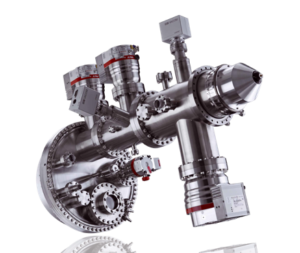Near Ambient Pressure X-Ray Photoelectron Spectroscopy
Category
Characterization Tools
Description
Complete understanding of hydrogenation and dehydrogenation requires knowledge of the dynamic composition and chemical state of the surface while the reactions are taking place. Surface/gas reactions are believed to be a rate-limiting factor for many H storage materials and are controlled by the chemical and physical state of the surface and near-surface regions. Traditional XPS can only be used in ultra-high vacuum conditions, allowing only ex-situ hydrogenation experiments and subsequent XPS measurements in vacuum. But the chemical reactivity and surface species can vary greatly with and without gas pressure. Near ambient pressure X-ray photoelectron spectroscopy (NAP-XPS) provides this information. In situ studies with NAP-XPS can reveal the complex coupling between transport, surface reaction rates, and oxidation state changes when hydrogen storage materials (hydrides, sorbents) operate.1–9
System Specifications
Pressure range: UHV to 25 mbar
Sample temperature: Liquid N2 to >1,000°C
Energy resolution: <2.5 meV
Kinetic energy range: 5–3,500 eV
Detector: fast delay-line detector with 190 ps time resolution
Status
Online and available for use in collaboration with HyMARC.

Fig. 1. Near-ambient pressure XPS electron energy analyzer SPECS PHOIBOS150.
References
- F. El Gabaly, et al., “Measuring individual overpotentials in an operating solid-oxide electrochemical cell,” Phys Chem Chem Phys 12 (2010): 12138–12145.
- J. A. Whaley, et al., “Note: Fixture for characterizing electrochemical devices in-operando in traditional vacuum systems,” Rev Sci Instrum 81 (2010).
- C. J. Zhang, et al., “Measuring fundamental properties in operating solid oxide electrochemical cells by using in situ X-ray photoelectron spectroscopy,” Nat Mater 9 (2010): 944–949.
- W. C. Chueh, et al., “Highly Enhanced Concentration and Stability of Reactive Ce3+ on Doped CeO2 Surface Revealed In Operando,” Chem Mater 24 (2012): 1876–1882.
- F. El Gabaly, et al., “Electrochemical intermediate species and reaction pathway in H-2 oxidation on solid electrolytes,” Chem Commun 48 (2012): 8338–8340.
- Q. L. Chen, et al., “Observation of Oxygen Vacancy Filling under Water Vapor in Ceramic Proton Conductors in Situ with Ambient Pressure XPS,” Chem Mater 25 (2013): 4690–4696.
- W. C. Chueh, et al., “Intercalation Pathway in Many-Particle LiFePO4 Electrode Revealed by Nanoscale State-of-Charge Mapping,” Nano Lett 13 (2013): 866–872.
- Z. L. A. Feng, F. El Gabaly, X. F. Ye, Z. X. Shen, and W. C. Chueh, “Fast vacancy-mediated oxygen ion incorporation across the ceria-gas electrochemical interface,” Nat Commun 5 (2014).
- C. B. Gopal, F. El Gabaly, A. H. McDaniel, and W. C. Chueh, “Origin and Tunability of Unusually Large Surface Capacitance in Doped Cerium Oxide Studied by Ambient-Pressure X-Ray Photoelectron Spectroscopy,” Adv Mater 28 (2016): 4692–4697.
